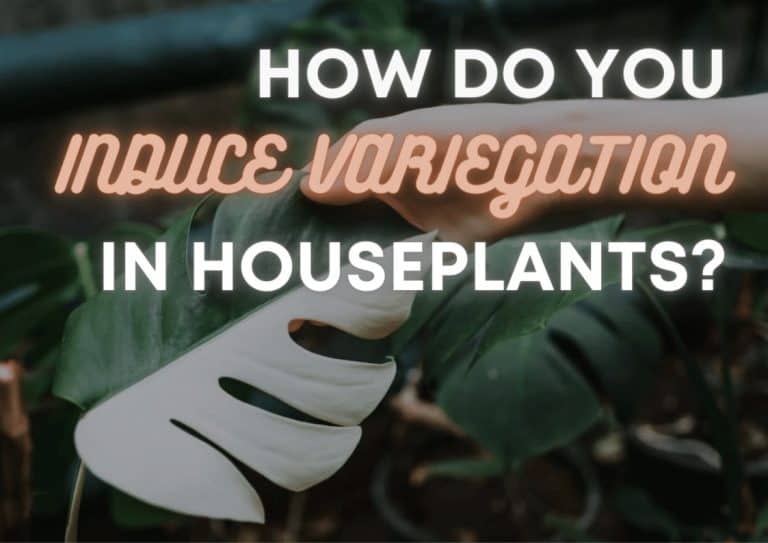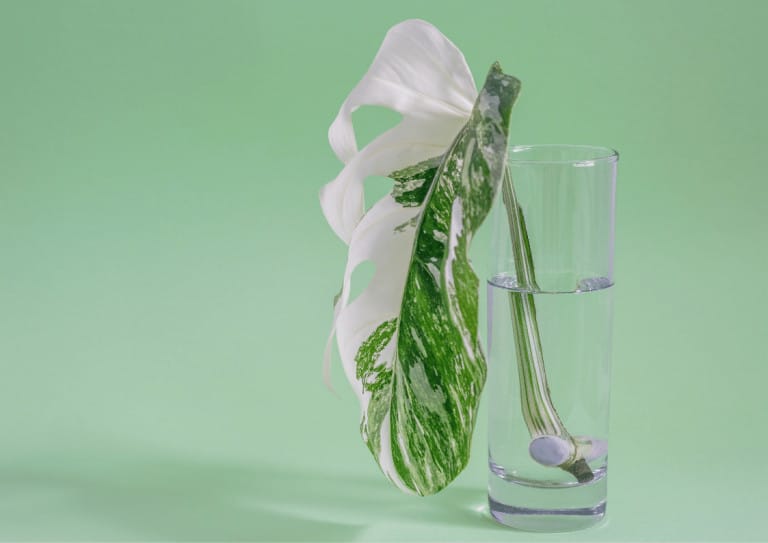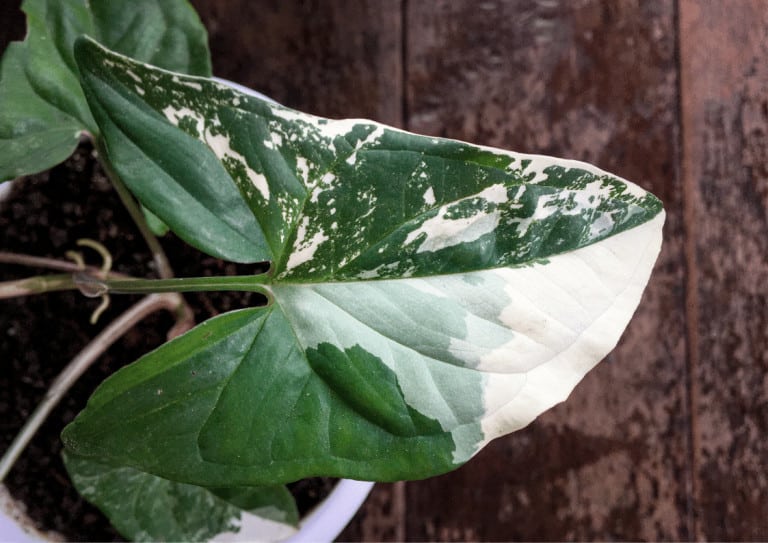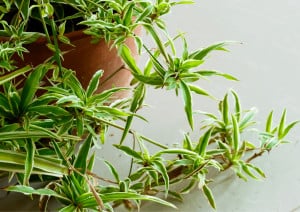How Do You Induce Variegation In Houseplants?
-
Chris Dosser
- August 1, 2022
If you buy something using the retail links in our articles, sometimes we earn a small affiliate commission. This does not impact the products we recommend.
Chimeric variegation in houseplants occurs when genetically distinct tissues exist next to one another. This can on occasion result in novel colored patterns being expressed on the leaves and flowers of a plant.
Variegated houseplants are much sought after by plant collectors and can demand some seriously high prices! It’s little wonder then that many indoor gardeners query whether or not its possible to trigger the color variations that could make their plant stock increase in value.
The good news is that it is possible to induce the production of variegated tissues in houseplants through various means including chemical mutagens (such as Ethyl methanesulfonate), exposure to ionizing radiation (such as X-Rays and Gamma Rays) and transposing genes from one plant to another.
The bad news however is that inducing variegation in plants using either of these methods is a complex process and not practical (or even safe) to attempt at home. The easiest way to obtain a variegated plant as an indoor gardener remains to simply to wait it out for a unique phenotype to appear spontaneously.
Below we’ll look at a few of the ways in which variegation can be prompted within houseplants, and in doing so demonstrate why they simply may be a stretch too far for regular houseplant hobbyists.

Inducing indoor plant variegation using chemicals
Chimera plants are produced through genetic changes in the nuclear or chloroplast genome that occur either spontaneously (the natural route) or by being induced.
Ethyl Methanesulfonate (EMS) is the most common chemical mutagen used by commercial plant breeders in an attempt to induce beneficial mutations.
Ethyl Methanesulfonate is applied to hydrated and metabolically active seeds by soaking them in an EMS solution (made using a low concentration phosphate buffer as water breaks down EMS rapidly) for 6-12 hours or soaking the roots of a young seedling with a lower concentration of EMS for a shorter duration.
Using EMS in this manner offers no guarantee that (I) the mutation will be phenotypically expressed, or (II) the mutation may generate the sought after distinctly colored tissue.
Mutations that commonly arise by using EMS can also impact the shape and number of leaves and flowers. So you might have to go through thousands of trials to generate anything near to the type of variegation that you see showcased on the #variegatemonstera hashtag.
Too much of the chemical can also affect the energy production systems of your plant, preventing it from creating enough energy to survive. For slow growing plants, or plants that are in a slow growing phase (such as during winter) this can have a devastating effect.
EMS is a mutagen so should only be used within the fume cupboard of a laboratory and appropriate personal protective equipment in place.
Inducing indoor plant variegation using radiation
Without going too deep into the science of how radiation impacts the growth and development of cellular material, inducing variegation in plants is achieved by exposing rooted cuttings to high energy electromagnetic radiation in the form of gamma rays or x-rays.
This has the effect of instigating chemical changes in the plant tissue by disrupting the structure of DNA.
In addition to causing variegation displayed as changes of color, irradiation can also cause an increase in the number of branches, number of flowers, and size of both flowers and leaves – with 100 Grays being the dosage that prompted the greatest observable change in a study published by the Journal of Pharmacognosy and Phytochemistry.
Anything greater than 300 Greys affected the condition of the plant so greatly that many of the study plants did not survive.
Of course, delivering gamma rays at this dosage (over 500x the levels emitted by everyday objects) is not something which is easily attempted outside of a lab setting – and so of little use to an ordinary indoor gardener.

Inducing indoor plant variegation through transposable elements
Genomic sequencing has allowed scientists to select and distribute desirable traits between plants.
Whilst chemicals and radiation cause changes to the plastids or mitochondrial DNA of a plant, transposing elements from one plant to another means that two genotypes are on display.
This is not as straightforward as simply grafting plant material from a variegated specimen to a non-variegated plant, but rather involves fragments of desired DNA being inserted into new chromosomal locations.
As an applied example of transposable material being of benefit, InnoTech Alberta have developed a stable genetic construct which exhibits bleaching on plant tissue as a visible marker when a desired gene is present within a plant’s genotype.
This modified bleaching can be applied to commercial crops (it was originally developed using tobacco plants) as well as variegated ornamental plants.
How can you maintain variegation in a houseplant that is reverting?
The loss in functioning chlorophyll which generates aesthetically desirable patterns in variegated plant tissue is disadvantageous to a plant in its natural habitat as it restricts its ability to generate energy.
Often variegated plants simply cannot outcompete their more vigorous non-variegated relative, and a chimeric variegation will be slowly selected out of new plant tissue.
To encourage a chimeric variegation to persist in a houseplant you can do two things:
First make sure to provide plentiful access to indirect light. The chlorophyll that remains functioning in leaves that are variegated need to feed the whole plant. N.B. Be aware that direct sunlight can damage plant cells that are absent of chlorophyll.
Secondly you can remove all of the ‘normal’ green leaves. This stops the plant from receiving feedback which registers that green leaves are better at producing sugars and starch (due to the greater levels of chlorophyll) and that to benefit its chances of survival it should grow more of these.

Round up
From the perspective of a house plant hobbyist we’ve learned that it is indeed possible to induce variegation in plants via mutations in the mitochondrial, plastid, and/or nuclear genomes.
However, doing so by means of chemicals, ionizing radiation or transposing genetic material is complex and not practical to attempt unless you have some degree of expertise in these areas.
For houseplant hobbyists, the best way to obtain a chimeric variegation in your houseplants is to simply wait it out for a spontaneous mutation to occur naturally.

Chris Dosser
Co-Founder of Eden Indoors
Chris is a self-taught horticulturist with over a decade of experience caring for houseplants and creating lush, thriving indoor oases. He specializes in Monstera, and by self admission has a serious problem with buying and propagating rare indoor plants!
Similar Posts
Is Rooting Hormone Poisonous To Cats & Dogs?
Rooting hormone is a must-have for many plant-lovers, but could it be dangerous or toxic to curious dogs and cats in your home?
Should I Cut The Babies Off My Spider Plant?
Will spider plant babies or the mother plant suffer if spiderettes remain attached for too long? Is there any benefit to cutting them off? Answers here.



